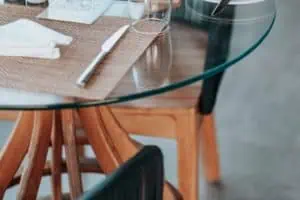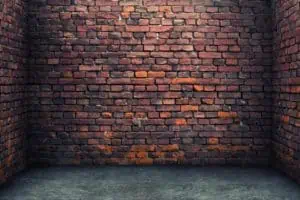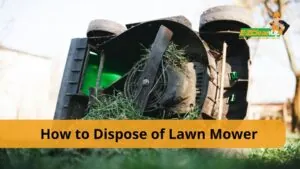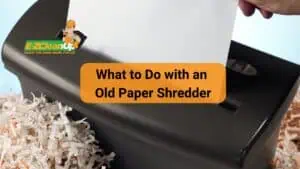To dispose of a ceiling fan, locate a nearby e-waste recycler or check with municipal waste services for recycling options. Some components may be recyclable, like metal or plastic. If functional, consider donation or resale.
Continue reading to explore more environmentally friendly methods of how to dispose of a ceiling fan.
Methods of Disposing Ceiling Fans
Ceiling fans, like many electrical appliances, contain materials that can be harmful to the environment if not disposed of properly. The recycling of these materials can conserve natural resources, reduce pollution, and even create job opportunities.
It’s vital to understand the composition of your ceiling fan and the best ways to recycle or dispose of its components to minimize its environmental footprint
E-Waste Recyclers: Finding the Right Facility
E-waste recyclers are your go-to for disposing of ceiling fans. These specialized facilities handle electronic waste and ensure the components are recycled correctly. They use processes that maximize material recovery with minimal energy usage.
Not all recycling centers accept entire ceiling fans, so it’s important to check with local facilities to see what parts they can take. The parts of a ceiling fan, like the blades, arms, flywheel, and motor housing, are often made of recyclable materials such as wood, aluminum, and plastic.
Utilizing Municipal Waste Management Services
Some municipal waste programs have the necessary facilities and equipment to recycle ceiling fans. However, it’s not a universal service; not all municipalities can handle electronic waste due to the presence of hazardous materials in electronics.
Before dropping off your ceiling fan at a local waste management facility, it’s a good idea to contact them and confirm if they accept such items. Remember, the goal is to ensure that your ceiling fan is disposed of in an eco-friendly manner.
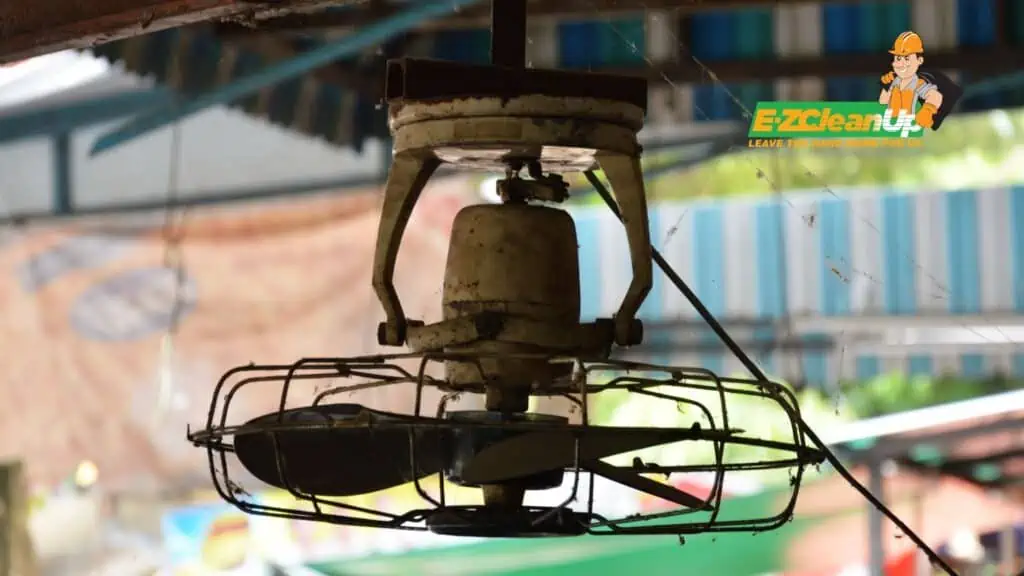
Manufacturer/Seller Take Back Programs
Some manufacturers and sellers of ceiling fans have take back programs. This means they’ll accept old fans and ensure proper disposal or recycling. It’s a hassle-free option, as these programs are designed to handle the product’s end-of-life responsibly.
You can check the manufacturer’s website or contact the seller where you purchased the fan to inquire about such programs. Retailers like Best Buy and Office Depot, and organizations like Recycle Nation, are known for these initiatives.
Participating in a take back program can be an easy and responsible way to dispose of your old ceiling fan.
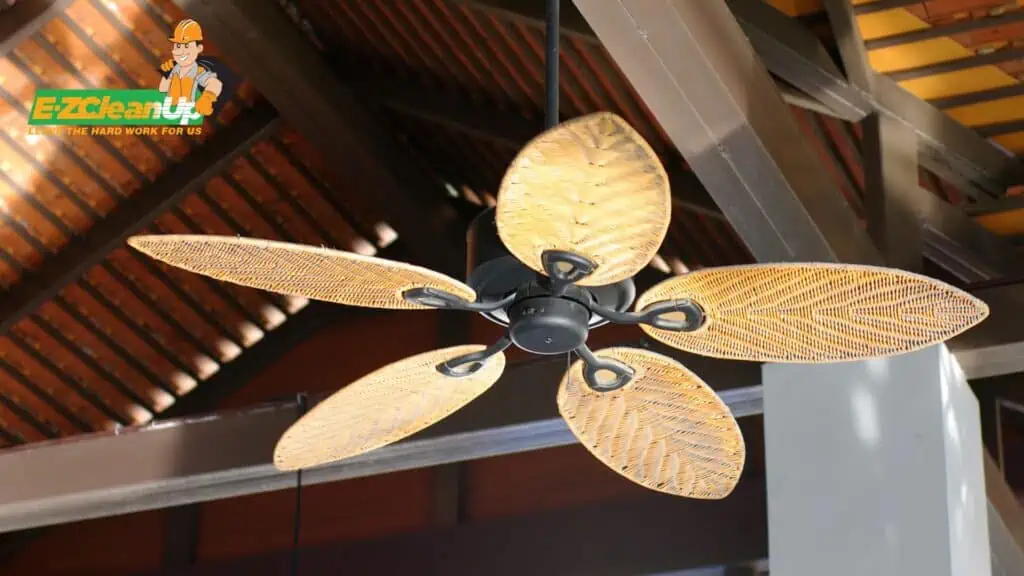
Donation Options for Usable Ceiling Fans
One great way to dispose of your old, but still functional, ceiling fan is to donate it. Organizations like Habitat for Humanity ReStores are ideal places for such donations. These stores accept a range of new and gently used building materials, including ceiling fans, and the proceeds from their sales help support their mission.
The process is simple: find your nearest Habitat ReStore, contact them to see if they accept ceiling fans, and you can either drop off the fan or schedule a pickup if they offer that service.
Selling Used Ceiling Fans
If your ceiling fan is still in good shape, selling it is another viable option. You can list your ceiling fan on online marketplaces like eBay or Amazon. Local online platforms such as Facebook Marketplace or Craigslist are also excellent choices for reaching potential buyers in your area.
This approach not only gives your fan a new home but can also earn you some extra cash. Plus, it’s a great way to promote reuse and recycling, reducing environmental waste. When listing your fan, make sure to provide clear pictures and details about its condition and specifications to attract the right buyers.
Recycling Components of Ceiling Fans
Fans, like other electronic appliances, contain materials that can be repurposed or reused.
Identifying Recyclable Parts
Ceiling fans consist of various recyclable materials. The blades may be made of wood, plywood, steel, aluminum, or plastic. The blade arms often include materials like aluminum and various metal alloys.
The motor housing is usually made of plastic, while the switch housing typically comprises metal and plastic. The downrod and the mechanism for mounting the fan to the ceiling are often metallic.
It’s important to note that recycling guidelines can vary based on your location, and not all recycling centers accept the same parts of a ceiling fan. Some centers might accept the entire fan, including blades, metal blade irons, and remote control batteries, while others may have more limited capabilities.
Steps for Recycling Fan Motors
Recycling the motor of a ceiling fan involves a few specific steps:
- Remove the Fan from the Ceiling: Start by safely disconnecting the fan from the ceiling. This involves turning off the power supply, unscrewing the mounting bracket, and gently lowering the fan.
- Disassemble the Fan: Carefully remove the blades from the motor housing. This will usually require unscrewing them. Next, detach any light fixtures or additional attachments.
- Extract the Motor: Separate the motor from the housing unit. Depending on the model, this might require additional tools and careful handling to avoid damage.
- Recycle the Motor: Once the motor is removed, it can be taken to a metal recycling facility or an e-waste recycler. It’s recommended to contact the facility beforehand to ensure they accept ceiling fan motors and to understand their specific requirements.
- Dispose of Non-Recyclable Parts Responsibly: Any non-recyclable parts, such as certain plastics or specific light bulbs, should be disposed of according to local regulations to minimize environmental impact.
How to Dispose of a Ceiling Fan – Upcycling Ideas
Ceiling fans, once they’ve outlived their usefulness, can be transformed into creative and useful items. This process, known as upcycling, involves repurposing old materials into new products.
Here are some innovative ideas for upcycling parts of ceiling fans:
Sculptural Dragonfly
Transform the fan blades and brackets into a decorative dragonfly.
- Materials Needed: Fan blades, brackets, wooden table legs, paint, screws.
Steps:
- Disassemble the ceiling fan to remove blades and brackets.
- Paint the blades and the wooden table leg in your desired colors.
- Once dry, attach the blades to the table leg to form dragonfly wings.
- Mount the assembled dragonfly on a wall or in the garden for display.
Ceiling Fan Coat Rack
Use the brackets that hold the fan blades as hooks for a coat rack.
- Materials Needed: Blade brackets, screws, mounting board.
Steps:
- Remove blade brackets from the fan.
- Mount these brackets onto a board or directly onto a wall.
- Use the protruding parts as hooks for coats or hats.
Farmhouse Ceiling Fan Update
For a fan that’s still functional but looks dated, you can update its appearance for a modern farmhouse style.
- Materials Needed: Paint, new light shades, screwdriver.
Steps:
- Paint the fan hardware in a color that matches the farmhouse style.
- Replace old light shades with more modern ones.
- Reassemble the fan for a refreshed look.
Junk Angel
Fan blades can be creatively used to make an angelic figure, which can serve as a charming piece of home decor.
- Materials Needed: Fan blades, paint, additional decorative items.
Steps:
- Paint the fan blades in a desired color or design.
- Arrange them to form an angel shape.
- Add decorative elements to enhance the angelic look.
Engraved Ceiling Fan Blade Wall Art
Engraving designs onto fan blades and then using dark wax can create a rustic, textured wall art piece.
- Materials Needed: Fan blades, engraving tools, dark wax.
Steps:
- Carefully engrave a design onto the fan blades.
- Apply dark wax to highlight the engraved patterns.
- Mount the blades on the wall as art pieces.
Pot Planters for Succulents
The fan’s motor housing can be repurposed into pot planters for small plants or succulents.
- Materials Needed: Motor housing, paint, soil, succulents.
Steps:
- Remove the motor from its housing.
- Paint the housing and let it dry.
- Fill with soil and plant succulents inside.
Large Garden Dragonfly Wings
Use the fan blades to create dragonfly wings for a large garden sculpture.
- Materials Needed: Fan blades, sturdy wire or metal rod, paint.
Steps:
- Paint the fan blades in a bright, dragonfly-inspired color.
- Attach them to a metal rod or wire to form large wings.
- Install in the garden as a decorative element.
Kitchen To-Do List Chalkboards
Ceiling fan blades can be turned into chalkboards for kitchen to-do lists or menus.
- Materials Needed: Fan blades, chalkboard paint, chalk.
Steps:
- Apply chalkboard paint to one side of the fan blades.
- Once dry, use chalk to write to-do lists or messages.
Coat Hangers
Repurpose the fan blade brackets into unique coat hangers.
- Materials Needed: Blade brackets, mounting hardware.
Steps:
- Remove the blade brackets from the fan.
- Mount them on a wall or board with the curved side up.
- Use these curves as hooks for coats or bags.
Bird Feeders
The light covers of the ceiling fan can be creatively turned into bird feeders for your garden.
- Materials Needed: Light covers, string or wire, bird feed.
Steps:
- Clean the light covers thoroughly.
- Attach a string or wire for hanging.
- Fill with bird feed and hang in a suitable location.
Pre-Disposal Steps for Ceiling Fans
Before disposing of a ceiling fan, it’s crucial to follow specific steps to ensure safety and proper disassembly.
Safety Measures: Turning Off Power
The first step to safely removing a ceiling fan is to turn off the power. This is done to prevent electrical accidents or injuries. Locate your home’s circuit breaker box and identify the breaker that controls the ceiling fan.
Switch it off, and double-check by trying to turn on the fan or using a voltage tester to confirm the power is indeed off. Always prioritize safety and use protective gear like safety goggles and gloves during the process.

Dismantling Process: Removing Fan Blades
Once the power is safely turned off, the next step is to remove the fan blades. Locate the screws or bolts that secure each blade to the motor housing, and use a screwdriver or wrench to remove them.
Work systematically, removing one blade at a time. If your fan has a light kit, it may need to be removed before accessing the screws attaching the fan to the ceiling.
Disconnecting Electrical Connections
After removing the blades, the next step is to disconnect the fan’s electrical connections. This involves carefully detaching the wires that run from the fan to your home’s electrical system. Use a screwdriver to access the wiring, and then disconnect the wires.
Cover the exposed ceiling wires with wire nuts or electrical tape for safety. It’s crucial to handle this step with care to prevent any electrical hazards.
Remember, if at any point you feel unsure or unsafe handling electrical components, it’s best to consult with a professional electrician.

Let EZ CleanUp Handle Your Ceiling Fan Disposal
Disposing of a ceiling fan in an eco-friendly way is important for the environment. Instead of just throwing it away, consider recycling or donating it. This helps reduce waste and protect our planet.
If this sounds complicated or time-consuming, don’t worry. EZ CleanUp is here to help. We specialize in junk removal, including ceiling fans and other e-waste. Reach out to us, and we’ll take care of your disposal needs in an environmentally responsible way. Let us make it easy for you.


